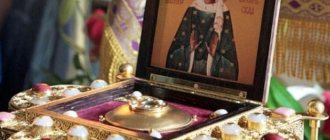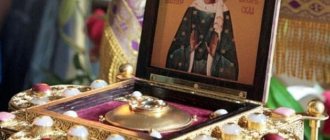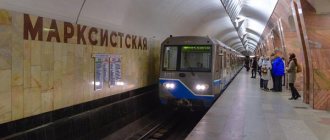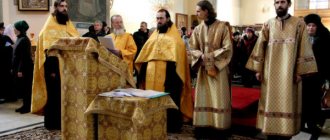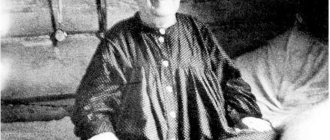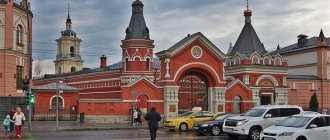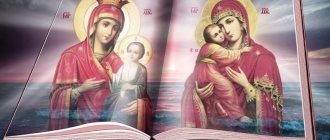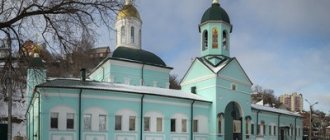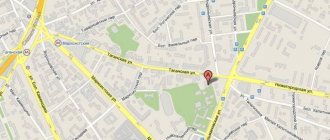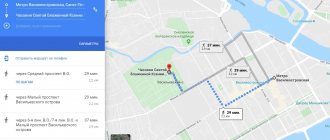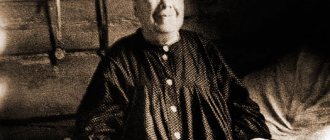"Save me, God!".
Thank you for visiting our website, before you start studying the information, please subscribe to our Orthodox community on Instagram, Lord, Save and Preserve † - https://www.instagram.com/spasi.gospodi/. The community has more than 60,000 subscribers. There are many of us like-minded people and we are growing quickly, we post prayers, sayings of saints, prayer requests, and timely post useful information about holidays and Orthodox events... Subscribe. Guardian Angel to you!
There are a large number of holy places throughout Russia. There are several of them in the capital. The most frequently visited is the Intercession Monastery in Moscow of St. Matrona. This is mainly due to the fact that a large number of pilgrims come there to venerate the relics of this Saint. After all, since 1998 they have been stored here.
Why did they begin to call the Intercession Monastery the Monastery of St. Matrona of Moscow
Now this is the name of one of the oldest monasteries in Moscow. This is due to the fact that since May 1, 1998, the relics of one of the people’s favorite saints of God, Elder Matrona Dmitrievna Nikonova, have rested here . After her canonization (May 2, 1999 as a locally revered saint, since 2004 she has been revered throughout the church) she is called Saint Matrona of Moscow.
Revered icon of St. Maroons in the Intercession Monastery
The description of a small part of the miracles that occur through prayer to the saint already takes up many volumes, even more - those that people do not make public, but keep in their hearts as precious evidence of God’s help through the prayers of His saint.
Address of the Intercession Monastery, how to get there
The monastery is located on the street. Taganskaya, 58. The area belongs to the Central Administrative District of the capital, located southeast of the historical center. Many streets and metro stations here retain their Soviet names. The nearest metro stations to the monastery:
- Marxist; After leaving the car, you must follow the sign “Exit to the street. Taganskaya"; at the nearest stop you can take any bus or trolleybus - they all go to the monastery; the “Bolshaya Andronevskaya” stop is the second after “Metro Marksistskaya”; some prefer to simply walk these two stops, which takes less than 20 minutes;
- Proletarskaya, Peasant Outpost - from here to Pokrovsky is only 10-12 minutes on foot, you should go along Abelmanovskaya Street; You can also take the tram, traveling 12, 36, 43 for only two stops.
Contacts
The Intercession Monastery (Suzdal) is located on Pokrovskaya Street 76. The postal code of the monastery is 601293. The monastery has its own website on the Internet, which contains up-to-date information for pilgrims, the schedule of services and excursions, main holidays and much more. You can view it at: spokrovmon_ru.
If you still have questions after studying the site, you can clarify them by calling the abbess of the monastery: +7-492-312-06-09. You can order excursion services by calling +7-915-792-43-84. You can write an email to E-mail: [email protected] _ru.
Schedule of work and services
The monastery opens early in the morning from 7 o’clock: after all, on weekdays the liturgy begins at 7.30 o’clock. And on Sundays, the gates of the monastery open from 6 o’clock, and at 6.15 the early liturgy is served, the late liturgy (9 o’clock). Every day after the liturgy, prayer services are served at the relics of the saint.
Evening services begin at 16.45. At the end of them, at approximately 20.00, the monastery gates are closed.
Patriarch Kirill at the relics of the blessed one. Matrona of Moscow
Is it possible to get to the monastery now, are pilgrims allowed?
There are currently no announcements for pilgrims on the monastery’s website indicating restrictions on visits. In the monastery group of the social network “VKontakte”, where many who come from afar are actively interested in whether there are restrictions on visiting, there is also no information about this. And pilgrims who have visited here report that there are no obstacles to visiting. At the same time, a mask regime is in effect, and upon entry a security guard can take your temperature.
Hotel
In 2015, the Pokrovskaya Hotel was consecrated; it is also located on the street. Taganskoy, 58, building 12. A single room here is quite expensive for a pilgrim coming from the provinces - from 6,000, a double room will cost from 3,500 rubles. to every guest.
Hotel phone number
What time is access to the relics open?
Venerate the relics of St. Matrona of Moscow is available on weekdays from 7 to 20 o’clock, and on Sundays from 6 to 20 o’clock. You can also approach the image of the saint, which is located on the outer wall of the temple, after 20 o’clock; no one kicks out visitors, but experienced pilgrims Still, they recommend that those who are late for any reason try to get into the territory before 8 pm, when the monastery closes.
This is interesting: Relics of Matrona of Moscow in Moscow and other cities
Hotels in the area
There are no hotels for pilgrims on the territory of the monastery, so you will have to look for a place to stay overnight in the city.
Very close to the monastery on Pokrovskaya Street 35A there is a guest house Tavern near Prokop with a restaurant that serves delicious national dishes and European cuisine. The hotel serves a very rich breakfast. Spacious rooms with all amenities have a living area with a soft sofa and TV, a private refrigerator and a safe.
The hotel has free guarded parking, a garden with gazebos, a barbecue area, and a tour desk. Ski equipment rental and slope access are available. A budget room with 2 single beds can be rented for 1.9 thousand rubles.
You can stay nearby in the guest house on Pokrovka at the address: Pokrovskaya Street 41. This cozy guesthouse offers guests a wood-fired sauna, a shared kitchen and living room with a fireplace, and a private garden. Spacious rooms with natural wooden furniture are equipped with all necessary amenities.
Guests can enjoy delicious breakfasts in the morning. In summer you can have a barbecue outside in the garden. There are bicycle rentals and free parking for cars. Pets are allowed. Room prices start from 2 thousand rubles.
The Teatralny Hotel Complex on Krasnoarmeyskaya Street 30B offers accommodation very close to the monastery. Hotel guests have access to a trendy bar with refreshing drinks and delicious European cuisine, billiards and a private garden.
The hotel has a tour desk. Rooms are equipped with essential amenities including a desk, TV and refrigerator. Some apartments have a spa bath and a separate bedroom and living room. The hotel restaurant serves a good hearty breakfast for its guests. A standard 2-bedroom room with meals can be selected from 2.9 thousand rubles.
You can stay in a separate chalet in the garden at 45A Pokrovskaya Street of the Suzdal Like Home guest house. Guests can relax in the Russian sauna. There is free parking. All rooms have a private entrance, private bathroom, living room with TV and coffee maker, dining area with kitchenette, refrigerator and microwave, and terrace overlooking the garden. The cost of double accommodation starts from 4 thousand rubles.
The Intercession Suzdal Monastery amazes with its majestic centuries-old white stone buildings, as well as amazing legends and numerous ancient traditions, which the hospitable sisters of the monastery are happy to share with all pilgrims and tourists.
Modern life of the monastery
Now the monastery is stauropegial, that is, it reports directly to the Patriarch.
Abbess and sisters
Abbess Feofania (Miskina)
Since February 22, 1995, the sisters have been headed by Abbess Feofaniya (Miskina). Mother took monastic vows in 1990, and was tonsured into the mantle on April 14, 1995 by Patriarch Alexy II. The abbess managed to revive monastic life and restore churches.
It all started in October 1995, when the first liturgy took place in the dilapidated Church of the Intercession. Then the number of nuns, together with the abbess, was only 5. And the temporary iconostasis was built from plywood by mother’s brother, Alexander.
By 2014, there were 50 sisters. On the Internet page and in the churches of the monastery you can see an announcement that Pokrovsky invites both working women who want to work for the glory of God, and sisters “who want to devote their lives to God, from 18 to 60 years old.”
Now the monastery operates:
- Orthodox gymnasium at the Trinity-Lykovo courtyard;
- a shelter for girls from single-parent, disadvantaged families (since 2004);
- publishing house
History of the monastery
The monastery began its life in the 17th century. like a man's.
"Bozhedomye"
The place where it was built has long been called “Wretched Houses”, or “poor house”. In Christian Rus', following the example of Jerusalem, where there was “land for the burial of strange people,” that is, Jews who came from other places and were caught in the Holy City by a sudden death. Such a death was considered a bad sign, perhaps indicating the secret sins of the deceased. But, by the providence of God, just such a plot was bought from the potter by the Jewish high priests with 30 silver coins, which were returned to them by the disciple-traitor of Jesus Christ, Judas, overcome by despair from his act.
It is on this basis that a kind of cemeteries for the burial of the “rootless” in Rus' also began to be called the Houses of God, or “God’s House”. Didn’t Christ Himself walk as a stranger, without permanent residence, persecuted by everyone? Is it not He who receives the restless souls of those who suffered during earthly life? This was the significance of this place. There was a parish church of the Intercession of the Virgin Mary here - small, wooden. Here, famous and unknown servants of God were commemorated here unacceptably.
Base
On October 14, 1633, on the Intercession of the Most Holy Theotokos, Patriarch Filaret (in the world boyar Fyodor Nikitich Romanov), father of Sovereign Mikhail Feodorovich, reposed. After 2 years, the son, as a memory of his deceased parent-archpastor, decided to build a monastic monastery at the “Bozhedomye”. The choice, obviously, was connected with the dedication of the local church to the Intercession, and also with the fact that the intense prayer of the monks for those who rest here, of course, will give joy to the soul of the deceased Primate, to whose memory the monastery will be dedicated.
The king had just begun to build the monastery, and it was already completed by the patriarch’s grandson. Filareta, Alexey Mikhailovich. Funds for construction were obtained from the government leasing land for the construction of houses. That is why the monastery was called by the townspeople not only “Bozhedomskaya”, but also “room”.
From the “attached” monastery to the missionary center
By 1655, it was possible to rebuild the Church of the Intercession in stone. Gradually the brethren gathered. The name of the possible first abbot, Stefan, who previously served at the Annunciation Cathedral of the Kremlin, has been preserved. A special task of the monks was to commemorate all the dead buried on this land.
However, the monastery, apparently, was never particularly rich or prosperous; the monks lived modestly, and perhaps even poorly. Already by 1680, Pokrovsky was made “assigned” to the Zaikonospassky Monastery of the capital. It remained such until 1731. Then, in accordance with the then state policy, which since the time of Peter I had demanded “public benefit” from the monks, they tried to make the monastery a “school.” He was given independence by opening a seminary here. For the 1730s - 1770s. erected:
- the second stone temple of the Renewal of the Temple of the Resurrection of Christ in Jerusalem (the so-called Resurrection of the Word);
- a stone bell tower.
As for the seminary, it was closed over time, distributing the students to other theological schools. According to the “monastic states” introduced by Catherine II (1764), Pokrovsky was classified as “third class,” which meant a symbolic annual subsidy from the Synod of 300 rubles. At the same time, like other monasteries, all lands were completely taken away, so the situation of the monks for a long time was practically disastrous.
The already poor monastery experienced the invasion of Napoleon's troops especially hard - occupation troops were stationed on its territory, the French desecrated churches and took away shrines. Only by 1855 was it possible to restore the Church of the Resurrection of the Word and rebuild the stone walls.
New life was breathed into the monastery by the project of St. Innocent (Veniaminov), Metropolitan of Moscow. Vladyka decided to make Pokrovsky a missionary one. Since 1870, a school has been opened here for monastics who want to bring the Word of God to the pagans of the North, Siberia, Alaska, and China. However, work continued only until 1879, until the death of the archpastor.
Cemetery
Despite the very ambiguous attitude of the secular authorities towards the monastery, ordinary Muscovites loved it, revered the shrines, and many, including famous residents of the capital, wanted to be buried near the place where they had been praying for the dead for centuries.
The cemetery at Pokrovsky was the largest of the monastic necropolises of the capital, it occupied more than 5 hectares.
For example, here rest:
- many of the representatives of the famous Moscow Botkin family - for example, literary critic Vasily Petrovich Botkin, Dmitry Petrovich - collector, entrepreneur, others;
- local historian Nikolai Naydenov, publisher of albums about the capital's churches;
- missionary, creator of a grammar of the Yakut language, Bishop Dionysius (Khitrov), many other famous and unknown Muscovites.
Timelessness
After the arrival of Soviet power, the monastery continued to operate for some time. Its churches were closed only in 1926, after which the bell tower was demonstratively blown up.
It is known that the last governor of Pokrovsky before his liquidation by the Soviet authorities was Archimandrite Veniamin (Milov). He took monastic vows after the revolution, in 1920, knowing full well what he was dooming himself to. He was arrested in October 1929, and then the monastery was finally closed.
In anticipation of the inevitable arrest, Fr. Benjamin wrote memoirs entitled “The Diary of a Monk.” He writes with humility about what is happening: “I thank God... The Lord taught me, a sybarite and lover of a quiet life, to endure cramped conditions, inconveniences, sleepless nights, cold, loneliness, and showed the extent of human suffering.”
Many monks were expected to receive crowns of martyrdom, but the Lord judged Father Archimandrite to perform the feat of confession. In total, he was arrested three times, the last time in 1949. He went through camps and exile. And on February 1, 1955, he became the bishop of Saratov and Balashov, but this, already the last obedience, lasted less than a year - on August 2, 1955, the bishop died. He has not yet been canonized, although many Orthodox believers are confident that the confessor is a saint. A record of miracles through prayers to him is being kept, and on July 8, 2016, the flow of myrrh from the cross on the grave was witnessed.
As for the monastery itself, its territory was occupied by Soviet institutions. By 1992, there were up to forty of them here. The greatest pain was caused to believers by the systematic destruction of the necropolis in the 1930s. A “recreation park” was set up in its place. Subsequently, the “petrified insensitivity” of many city residents who grew up under the Soviet system would reach the point that in the 2000s. A whole social movement will begin against the transfer of Tagansky Park, a “recreation place” to the monastery. In 2009, the authorities refused this due to... “lack of legal grounds.”
New life
It began on November 24, 1994, when a decision was made to resume monastic life at the holy place. But the monastery was revived as a convent.
Architecture, appearance
The main compositional center of the monastery is the 3-domed Intercession Cathedral, built in 1518, erected by unknown craftsmen on the site of a wooden building. This powerful 4-pillar building with a high ground floor is surrounded along the perimeter by a 2-story bypass gallery with covered ceremonial staircases decorated with arched porches.
On the side of the altar there are 3 apses with high, deep window niches and smooth columns. The white stone walls are decorated strictly; they are decorated with arched-columnar belts and keel-shaped zakomaras. The carved cornice is decorated with small, subtle ornaments that are repeated in the light drum. Helmet-shaped gilded domes are topped with openwork crosses.
The lower church, consecrated in the name of St. Sophia of Suzdal, became the beginning of the revival of the monastery. It was there that services began after a long break. Here are the ancient graves of famous ascetics of the monastery. To the north of the main cathedral rises a bell tower, built in a tent style.
The lower tier of the belfry is occupied by a church, erected as a single-domed structure in the shape of an octagon in 1515. After 2 centuries, it was built on a floor with arched openings for bells, above which rises a sharp stone tent with several rows of framed lucarnes or dormer windows.
The church is connected to the bell tower by a covered gallery, decorated with arches with rustication, and at the top there is a row of windows with pilasters and decorative frames. Here you can hear an ancient bell from the second half of the 16th century, donated to the monastery by local nobleman Demid Cheremisin.
In the Holy White Stone Gate there are buildings from the same period, crowned with a powerful 3-domed quadrangle, where the gate church of the Annunciation is located. There is a covered gallery with arched vaulted openings around the church. The facades are decorated with patterned carved ornaments. The building is designed in the form of a fortress tower with 2 through arches of different sizes at the bottom, covered with powerful gates.
The Winter Conception Church with a refectory chamber was erected a little later, in the middle of the 16th century, according to the royal instructions and donations of Ivan the Terrible, in memory of his deceased daughter Anna. The upper part of the perimeter of the powerful walls of the single-domed temple is unusually decorated with large rhombuses made of red brick.
The original fine masonry of the vaults and walls was characteristic of Polish architecture, which suggests the foreign origin of the architect invited to the construction by Elena Glinskaya. The powerful rectangular 2-story building, in addition to the single-pillar refectory on the 2nd floor, housed kitchen and utility rooms, warehouses, and a bakery.
Intercession Monastery Suzdal, complex infrastructure.
A church with a simple square apse adjoins the eastern part of the building, and a low bell tower with an arched level for ringing, a row of dormers and a hip roof was later added to the west.
The building of the executive chamber or court house, built at the end of the 17th century, today is occupied by a historical museum exhibition with a unique monastery archive; in the underground floor, the chambers of a stone bag for holding prisoners are recreated.
The powerful fortress wall of the monastery fence was partially preserved from the 17th-18th centuries, and in the last century it was recreated in the destroyed parts by the architect-restorer Varganov. The inner part of the fence with narrow loophole windows for military-defensive purposes has supports for walkways in the form of wooden flooring on blind stone arches.
The ancient hipped towers of the fortress wall are practically devoid of decoration; later buildings are made in the form of 8-sided walls with elegant windows with platbands, horizontal rods and picturesque loopholes. These towers are completed with hemispheres of domes with a spire.
Shrines
The main one is the relics of St. Matrona of Moscow.
In addition, pilgrims come:
- to the holy icon; it is located on the wall of the Intercession Church; people come to her, as to the relics of a righteous woman, in a continuous stream;
- to the image “Recovery of the Lost”; This is an icon of the Mother of God, painted with the blessing of St. Matrons;
- venerate the reliquary icons of St. Nicholas of Myra, St. Neil Stolobensky.
All these shrines are in the Church of the Intercession. In the Church of the Resurrection of the Word there are also at least a dozen revered images, arks with the relics of saints of God, including the Kiev-Pechersk saints, Queen Theophania, St. John of Shanghai, others.
Interior decoration
The Intercession Monastery (Suzdal) has a very ascetic interior design of the temples. Whitewashed stone walls without frescoes or paintings go perfectly with black ceramic floor tiles.
At the bottom of the internal walls of the temple there are functional niches that were used to store liturgical utensils, books and church objects.
The main decoration of the strict interior decoration of the Intercession Churches is concentrated in its iconostasis, holy faces and skillful artistic monastic embroidery, some of which is currently stored in various museum exhibitions in the country.
